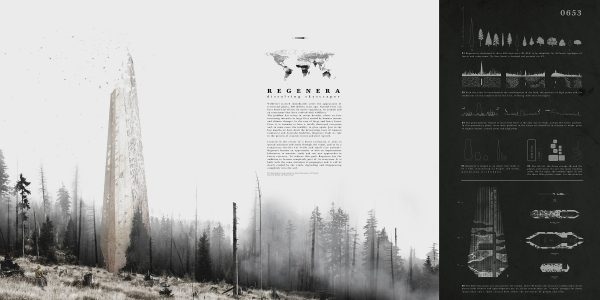Honorable Mention
2020 Skyscraper Competition
Alberto Roncelli
Italy
Wildfires started immediately after the appearance of terrestrial plants, 420 million years ago. Natural fires can have beneficial effects on native vegetation, on animals and on ecosystems that have evolved with wildfires. The problem has arisen in recent decades, where we are facing increasing intensity in large fires caused by humans (arsons and climate change). In the case of large and heavy forest fires, it is common to have a totally destroyed ecosystem and, in some cases, the inability to regrow. In recent months we have dealt with the devastating cases of the Amazon rainforest and the bushfires in Australia with over 12.35 million acres of scorched earth and 480 million dying animals. Which role can architecture and architects play in this scenario? Can we suggest new approaches for ecosystem recovery?
Idea
Regenera finds its role in the process of ecosystem recovery and forest regrowth.
Located in the center of a burnt ecosystem, the project aims to spread nutrients and seeds through winds and to be a temporary shelter for birds and small size animals. The skyscraper will accompany its ecosystem during all the phases, from the burnt forest until the total recovery. It is through the erosion of its own structure and consequently through its dissolution that Regera can transform and spread itself into the ecosystem. During the initials phases, a laboratory on the lower level is dedicated to experiment, monitor and research the ongoing process and the ecosystem progresses. In the following phases, the scientists abandon the skyscraper allowing the re-population of small and medium-size animals and plants. While the forest regrows, Regenera dissolves.
From materials to substances
The new paradigm suggested by Regenera is the possibility to carefully program and diversify each part of the structure, defining a life cycle determined by erosion and constant transformation. The act of choosing materials is evolved in the act of mixing substances needed by the forest, dealing with the paradox of structure and precariousness. Regenera is a vision that needs chemists, psychogeographers, meteorologists, engineers, and biologists, all involved to understand the necessities of each dead ecosystem. In the end, Regenera tries to be a manifesto for a new possible way of relating architecture and nature, structure and ecosystem, time and erosion, skyscrapers and forests.

















